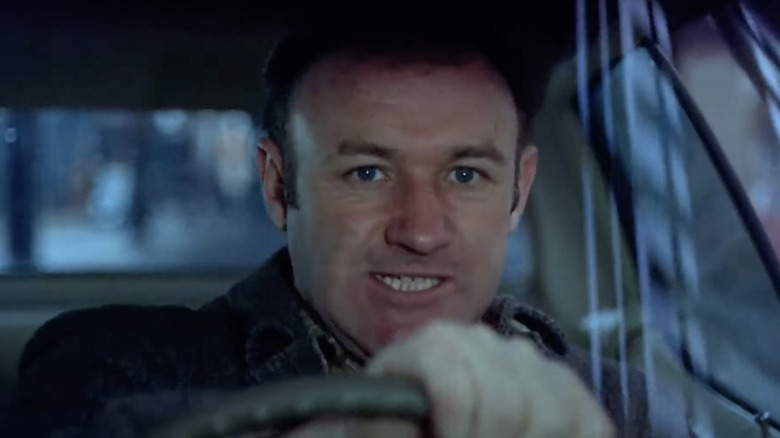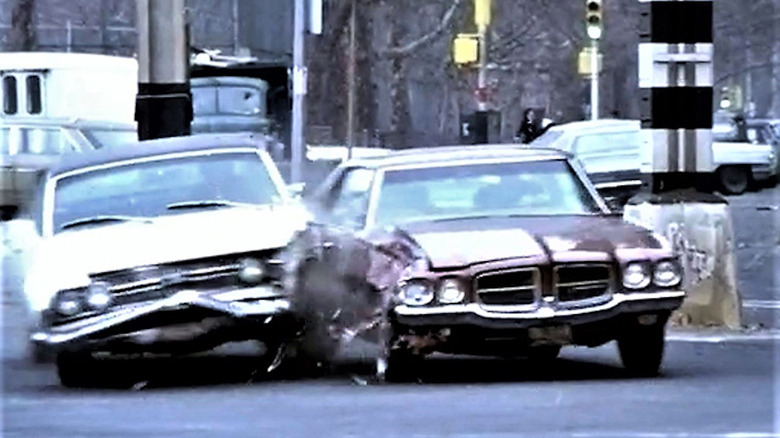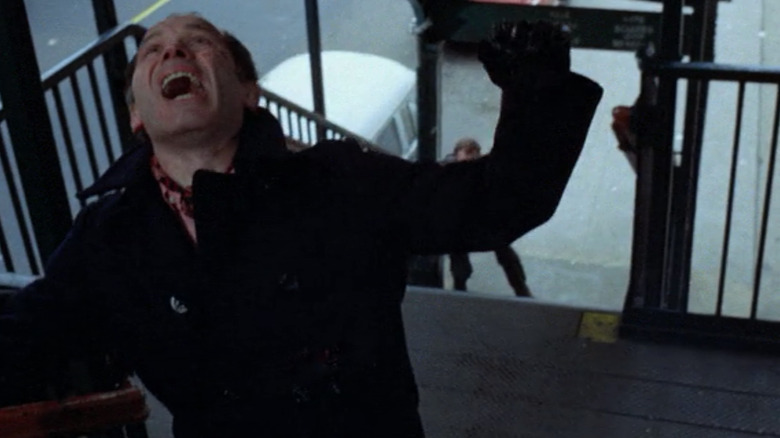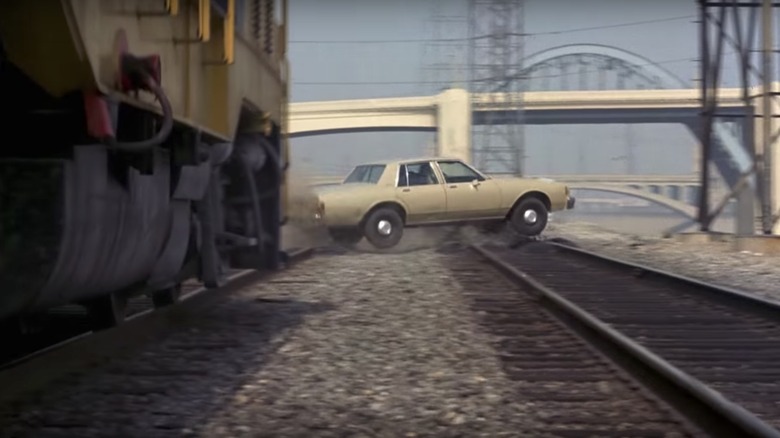How William Friedkin's The French Connection Defined The Modern Movie Car Chase
There were car chases in movies before Peter Yates' "Bullitt," but the notion of the car chase as a showstopping set piece did not really exist before Steve McQueen hopped in a Highland Green Ford Mustang GT fastback and tore ass all over the hilly streets of San Francisco. Suddenly, vehicular mayhem was an obligatory bit of business for any action film set in the time of automobiles. And just as suddenly, these scenes became cliche-laden snoozefests shot on second-unit autopilot.
Those cliches — commandeering a civilian's car, dodging baby carriages, etc. — are not a feature of Yates' pioneering sequence, but they are key elements of Popeye Doyle's frenetic pursuit of an elevated subway train hijacked by a drug dealer's hitman in William Friedkin's "The French Connection." Did Friedkin, who passed away today at the age of 87, know he was establishing the template for the modern action movie when he terrorized Bensonhurst, Brooklyn with a hard-charging Pontiac LeMans? Probably not. Friedkin was not a precious filmmaker. Not in the moment, at least. He worked on massive studio productions and gritty independent films at various points in his career, and what mattered most to him was believability. That's why "The Exorcist" is still one of the most terrifying movies ever made; if demonic possession were possible, this is what it would look like (which is why I think Friedkin erred by re-inserting the spider-walk jump scare).
Every single second of "The French Connection" is equally authentic. This is what big-city policing looked like. It might've been too authentic (and it's possible Friedkin took the mystery of Doyle's recently-excised utterance of the n-word to the grave), but this depiction of a jaded New York City detective driven to get his perp set the tone for cop flicks going forward. And that car chase is still, on some level, the gold standard for a character defined through breakneck action.
Bumper cars in Bensonhurst
The Bensonhurst chase sequence has been broken down in precise detail by critics, teachers, and William Friedkin himself, so I'm not going to get in the weeds here. I will use this space to dispel the persistent myth that Friedkin shot the scene without permits — at least when it came to the Transit Authority. According to Friedkin, who loved spinning a yarn, he obtained an official permit to shoot on what was then the B train by paying an unnamed official $40,000 and furnishing them with a one-way ticket to Jamaica (the country, not the neighborhood in Queens). At street level, however, he evidently relied on the sotto-voce cooperation of the NYPD (helped along by Eddie Egan, the real-life Popeye Doyle) to hurtle a piece of metal down a crowded city street.
Friedkin claims the LeMans, piloted mostly by "Bullitt" stuntman Bill Hickman (Gene Hackman did a bit of driving, too), topped out at 90 miles-per-hour over a 26-block stretch, and, apparently, the single take of his drive can be seen in the film. But the shot that makes the sequence a singular white-knuckler comes courtesy of the camera mounted on the LeMans' front bumper, which cinematographer Owen Roizman undercranked to enhance the sense of velocity (and this ain't BS because you can see exhaust billowing out of cars at the sped-up rate). Moviegoers had never been placed behind the wheel of a speeding car in such a realistic manner, and while countless directors would try to replicate this experience, they generally lacked Friedkin's cinematic skill and chutzpah. Fifty-two years later, we're still clutching our armrests when we throw on "The French Connection."
A perfectly paced chase that cuts extraneous detail
William Friedkin's madness is the stuff of legend, but what I love most about this scene is the editing — and, in particular, what we don't see. I always get caught up in the situational logic of it. It's smart and controlled. Doyle's on tilt because the mobster shot at him, so everything at street level is buyable.
The tension on the train is trickier. Nicoli (Marcel Bozzuffi) is trapped. Sooner or later, this train will meet its terminus. But he's got a gun and has zero compunction about using it, which gives him a decided advantage over the passengers, the motorman, and the conductors. A hack director might throw some stupidly courageous cannon fodder at Nicoli, but the civilians are appropriately panicked. The conductors try to present a unified front, but you can't negotiate with bullets. In any event, Friedkin takes care with these scenes, and he flatters the viewer's intelligence by eliding necessary shots. For example, when Doyle runs up to the subway platform and sees the B train blow through the station, he cuts back to the motorman's compartment and hangs there for a bit. When he cuts back to Doyle, he's already screaming down the boulevard in the LeMans. Friedkin didn't have to show him running back to the car. That was assumed because we know Doyle is all in.
As for the poster-promised coup de grace ... yes, Doyle shoots Nicoli in the back. But the way Bozzuffi explodes to the camera at the top of the steps is emblazoned in our collective cinematic consciousness. Morally, this is hideous. Visually, thematically, it's Doyle to a T. Friedkin's not endorsing Doyle's behavior. He's depicting it. And if you get off on it, if you cheer it (and a lot of people did), that's on you. This is what a great filmmaker does.
Do it again, and do it better
You know what else a great filmmaker does? He weathers a series of catastrophic flops ("The Brink's Job," "Sorcerer," "Cruising" and "Deal of the Century"), and bounces back with an all-time banger in "To Live and Die in L.A." And knowing his rep as the constructor of perhaps the car chase to top all car chases, he tries to top his masterpiece.
As far as I'm concerned, he pulled it off.
"To Live and Die in L.A." is a radically different beast. It's a paranoid procedural built around an explicitly suicidal Secret Service agent (William Petersen) who involves his new partner (John Pankow) in an unhinged counterfeiting investigation. This plunges them headlong into a bungled buy of stolen diamonds that kicks off a car chase which concludes with Petersen barreling up a freeway off-ramp into oncoming traffic.
The freeway finale deservedly gets most of the praise, but before the agents are chased into this desperate situation, they're dodging assault rifle fire along the banks of a railroad-adjacent reservoir. There's an insane stunt that involves Petersen's car speeding past a train engine and cutting across its path. Before that, there's a high-speed crane shot at the 1:43 point of this video that I think only a maniac like William Friedkin would try to pull off. No one would dare to make a film as logistically complex and fundamentally nasty as "To Live and Die in L.A.," and I think this is a dreadful thing because we live in fundamentally nasty times.
Here's the good news: No one was seriously injured during the filming of these scenes. Here's the not-so-great news: "To Live and Die in L.A." is currently unavailable to stream anywhere. As for "The French Connection," it's out there, and it's a must-see/must-revisit. As for Friedkin, he was a wonderfully entertaining raconteur who helped rescue Hollywood in the early 1970s. He was nuts in the best way, and I will miss him dearly.



